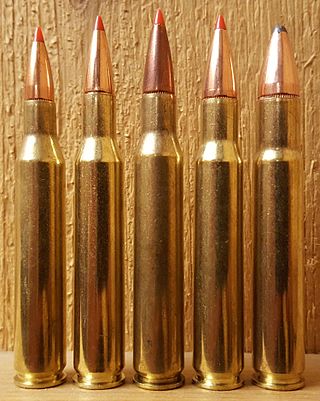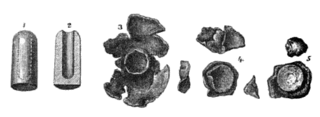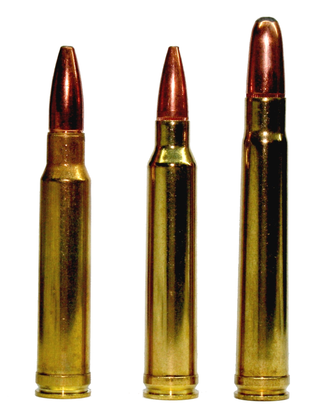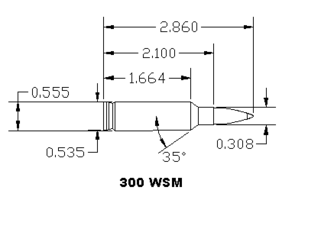
The .460 Weatherby Magnum is a belted, bottlenecked rifle cartridge, developed by Roy Weatherby in 1957. The cartridge is based on the .378 Weatherby Magnum necked up to accept the .458-inch (11.6 mm) bullet. The original .378 Weatherby Magnum parent case was inspired by the .416 Rigby. The .460 Weatherby Magnum was designed as an African dangerous game rifle cartridge for the hunting of heavy, thick skinned dangerous game.

The .270 Winchester is a rifle cartridge developed by Winchester Repeating Arms Company in 1923, and it was unveiled in 1925 as a chambering for their bolt-action Model 54 to become arguably the flattest shooting cartridge of its day, only competing with the .300 Holland & Holland Magnum, also introduced in the same year.

The term express was first applied to hunting rifles and ammunition beginning in the mid-19th century, to indicate a rifle or ammunition capable of higher than typical velocities. The early express cartridges used a heavy charge of black powder to propel a lightweight, often hollow point bullet, at high velocities to maximize point blank range. Later the express cartridges were loaded with nitrocellulose-based gunpowder, leading to the Nitro Express cartridges, the first of which was the .450 Nitro Express.
A rim is an external flange that is machined, cast, molded, stamped, or pressed around the bottom of a firearms cartridge. Thus, rimmed cartridges are sometimes called "flanged" cartridges. Almost all cartridges feature an extractor or headspacing rim, in spite of the fact that some cartridges are known as "rimless cartridges". The rim may serve a number of purposes, including providing a lip for the extractor to engage, and sometimes serving to headspace the cartridge.
The .416 Rigby is a rifle cartridge designed in 1911 by London based gunmaker John Rigby & Company, for hunting dangerous game. It is the first cartridge to use a bullet of .416 inch diameter. The rifles, as built by John Rigby & Co., were initially made up on the Magnum Mauser 98 action, although in later years, some were made on standard length actions, a perfect example being the rifle used by legendary professional hunter Harry Selby. Other famous users of the cartridge were Commander David Enderby Blunt, John Taylor, and Jack O'Connor.

The .375 H&H Magnum, also known as .375 Holland & Holland Magnum, is a medium-bore rifle cartridge introduced in 1912 by London based gunmaker Holland & Holland. The .375 H&H cartridge featured a belt to ensure the correct headspace, which otherwise might be unreliable, given the narrow shoulder of the cartridge case. The cartridge was designed to use cordite which was made in long strands – hence the tapered shape of the case, which, as a beneficial side effect also helped in smooth chambering and extraction from a rifle's breech.

The .300 Winchester Magnum is a belted, bottlenecked magnum rifle cartridge that was introduced by the Winchester Repeating Arms Company in 1963. The .300 Winchester Magnum is a magnum cartridge designed to fit in a standard rifle action. It is based on the .375 H&H Magnum, which has been blown out, shortened, and necked down to accept a .30 caliber (7.62 mm) bullet.

The .338 Winchester Magnum is a .338 in (8.6 mm) caliber, belted, rimless, bottlenecked cartridge introduced in 1958 by Winchester Repeating Arms. It is based on the blown-out, shortened .375 H&H Magnum. The .338 in (8.6 mm) is the caliber at which medium-bore cartridges are considered to begin. The .338 Winchester Magnum is the first choice among professional brown bear guides in Alaska to back up clients where a powerful stopping caliber is required on charging bears. It is also the most popular medium-bore cartridge in North America and has the most widely available choice in rifles among medium bore rifles. The action length is the same as a .30-06, and most major rifle manufacturers in the United States chamber rifles for the cartridge including the semi-automatic Browning BAR Mk II Safari, making it a very powerful combination against charging dangerous game. The cartridge was intended for larger North American big-game species and has found use as for the hunting of thin-skinned African plains-game species.

The 7mm Remington Magnum rifle cartridge was introduced as a commercially available round in 1962, along with the new Remington Model 700 bolt-action rifle. It is a member of the belted magnum family that is directly derived from the venerable .375 H&H Magnum. The original purpose of the belted magnum concept taken from the .300 H&H Magnum and .375 H&H Magnum, was to provide precise headspace control, since the sloping shoulders, while easing cartridge extraction, were unsuitable for this purpose. Improved cartridge extraction reliability is desirable while hunting dangerous game, in particular when a fast follow-up shot is required. The 7mm Remington Magnum is based on the commercial .264 Winchester Magnum, .338 Winchester Magnum, and .458 Winchester Magnum, which were based on the same belted .300 H&H Magnum and .375 H&H Magnum cases, trimmed to nearly the same length as the .270 Weatherby Magnum.

The .35 Whelen is a powerful medium-bore rifle cartridge that does not require a magnum action or a magnum bolt-face. The parent of this cartridge is the .30-06 Springfield, which is necked-up to accept a bullet diameter of .358 in (9.1 mm). This cartridge is more powerful than its parent, especially in killing power on large game. However, with much wider availability, and the higher BC .30 caliber bullets of today, the power gap between the two cartridges has been decreased.

300 Winchester Short Magnum is a .30 caliber rebated rim bottlenecked centerfire short magnum cartridge that was introduced in 2001 by Winchester.
The .300 H&H Magnum cartridge was introduced by the British company Holland & Holland as the Super-Thirty in June, 1925. The case was belted like the .375 H&H Magnum, and is based on the same case, as also is the .244 H&H Magnum. The belt is for headspace as the cases' shoulders have a narrow slope rather than an actual shoulder. More modern magnums continue this practice, but headspacing on the belt is not necessary with their more sharply angled shoulders. The cartridge was used by American shooter Ben Comfort to win the 1000-yard Wimbledon Cup Match at Camp Perry in 1935, and it was used again to win the international 1,000 yard competition in 1937. Winchester chambered the Model 70 in .300 Holland & Holland Magnum in 1937.

The .416 Remington Magnum is a .416 caliber (10.57 mm) cartridge of belted bottlenecked design. The cartridge was intended as a dangerous game hunting cartridge and released to the public in 1989. The cartridge uses the case of the 8 mm Remington Magnum as a parent cartridge. When the cartridge was released in 1988, author Frank C. Barnes considered the .416 Remington Magnum to be the "most outstanding factory cartridge introduced in decades".
The .375 Ruger (9.5×65.5mm) is a rimless, standard-length rifle cartridge designed for hunting large, dangerous game. It is designed to provide an increase in performance over the .375 H&H cartridge within the context of a standard-length rifle action. The cartridge was designed in partnership by Hornady and Ruger. In 2007, it was released commercially and chambered in the Ruger Hawkeye African and the Ruger Hawkeye Alaskan rifles.
The .375 Dakota is dangerous game cartridge designed by Don Allen, the founder of Dakota Arms of Sturgis, South Dakota.
The .400 H&H Magnum also known as .400 Holland & Holland Magnum is a belted rimless bottlenecked cartridge introduced by Holland & Holland. The cartridge was released together with the .465 H&H Magnum in 2003. It is based on the .375 H&H Magnum case.

The .458 Lott is a .458 caliber rifle cartridge designed for the purpose of hunting large, thick-skinned dangerous game animals in Africa. It is based on the full length .375 H&H Magnum case blown out and shortened to 2.800 inches (71.1 mm).

The .275 Holland & Holland Magnum is a semi-obsolete rifle cartridge similar to the 7mm Remington Magnum. Essentially the .275 Holland & Holland Magnum is a necked down shortened variant of the .375 Holland & Holland Magnum. It was introduced by the British company Holland & Holland with the .375 Holland & Holland Magnum that was introduced in 1912 as the .375 Belted Rimless Nitro-Express. The .375 Holland & Holland Magnum was intended for dangerous African game animals, while the .275 Holland & Holland Magnum was intended for longer range shooting of antelope in Africa and Red Stag in the highlands of Scotland.
The .416 Ruger is a .41 caliber, rimless, bottlenecked cartridge designed as a joint venture by Hornady and Ruger in 2008. It is designed to equal the performance of the .416 Rigby and .416 Remington Magnum from a standard length .30-06 length action. The .416 Ruger is suitable for the largest land animals, including dangerous game.
The .338 Ruger Compact Magnum or .338 RCM is a rimless, short-length rifle cartridge based on the .375 Ruger case. Sturm Ruger and Hornady jointly developed the round, which was released in 2008 and chambered in various Ruger rifles. The goal of the project was to produce a .338 caliber cartridge with magnum level performance that would fit in a compact, short action rifle. The .338 RCM is conceptually similar to the WSM cartridge family, but is somewhat smaller dimensionally. This often allows for a higher magazine capacity than the WSM equivalent. Like the .338 caliber cartridges which predated it, the round is designed for hunting medium to large sized North American game.










